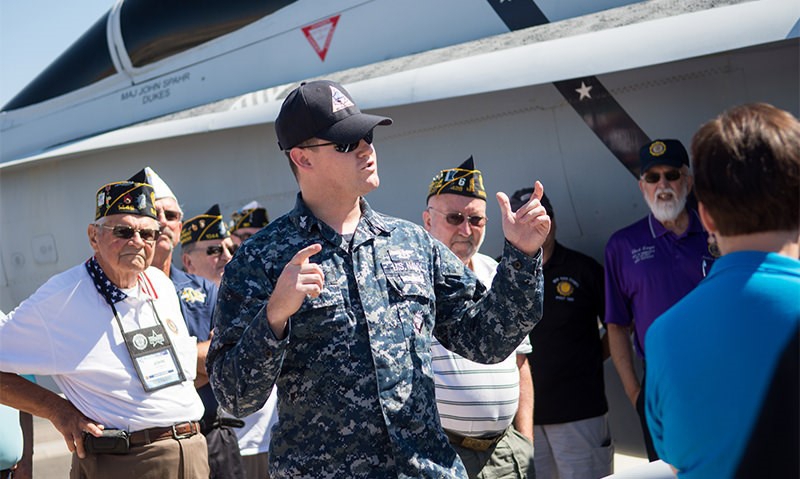
Legion’s National Security Commission takes field trip to Naval Air Station Fallon in Nevada.
More than 70 Legionnaires from across the country joined The American Legion’s National Security Commission on a field trip Aug. 18 to explore the Navy’s premier one-stop air warfare training facility – Naval Air Station (NAS) Fallon.
The trip, held in conjunction with the Legion’s 99th National Convention in Reno, Nev., included an oral presentation and group tour led by NAS Public Affairs Officer Zip Upham. Upham began the tour inside the air observation deck, wherein the group saw a bird’s eye view of the NAS Fallon's runway, aircraft fleet and geographic landscape encompassing multiple air spaces for training operations.
“The Navy has been out here since 1942,” Upham said. “The reason the Navy is in the middle of the Nevada desert is for two primary reasons. The first of which is we tend to have excellent weather over 300 days a year – that involves the air here at the air station and also the air mass out over the ranges. The ranges that we have out to the east are some of the most critical real estate to the Navy. The other reason the Naval base is here in northern Nevada is because we have relatively few neighbors.”
According to the commander, Navy Installations Command website, NAS Fallon traces its origins to 1942 when the Civil Aviation Administration and the Army Air Corps began construction of four airfields in the Nevada desert. As the war in the Pacific developed, the Navy recognized a need to train its pilots in a realistic environment using all the tactics and weapons currently being developed.
NAS Fallon was later commissioned on Jan. 1, 1972, when the Navy upgraded the base to a major aviation command. New hangars, ramps, housing and other facilities were added to give the installation new and greater capabilities.
Over the next 30 years, the air station grew to become one of the premier training sites for Navy/Marine Corps pilots and ground crews. Aviators around the world now recognize NAS Fallon as the pinnacle of air warfare training thanks to its:
· Four bombing ranges;
· Massive 14,000-foot runway which remains the longest in the Navy;
· Electronic warfare range;
· Naval Aviation Warfighting Development Center;
· Fleet Readiness Center;
· Fallon Range Training Complex;
· Explosive Ordinance Disposal; and
· Strike Fighter Wing.
“We have airspace going out 125 miles and we cover 13,000-square miles of sky,” said Upham, a former Naval intelligence officer. “We can generally go out and fly, fight and practice in that airspace and disturb relatively few people on the ground – something we can’t replicate anywhere else.”
During the 1980s, NAS Fallon experienced dramatic growth as a state-of-the-art air traffic control facility. The Naval Strike Warfare Center was established in 1984 as the primary authority for integrated strike warfare tactical development and training. It quickly became the graduate level training evolution that air wings go through during their inter-deployment training cycle, according to CNIC.
Moreover, the air station received the Tactical Aircrew Combat Training System in 1985 to aid in its aircrews training. This system provides visual graphic displays of missions for squadrons, carrier air wings and students from the Naval Strike Warfare Center.
“When we do training like that, it is not initial training; we are not teaching people to fly their aircraft,” Upham said. “Here, we’re trying to make them experts at using them in combat.”
Upham said NAS Fallon’s mission has not changed since 1942. With unequaled air warfare training and integrated facilities supporting present and emerging National Defense requirements, the air station is integral to keeping America’s Naval forces ready now and into the future.
“I thought (Upham) did a real fine job in explaining stuff to us. The whole tour today was beautiful,” said 42-year Legion member Mike Landkamer, a Vietnam veteran who served in the Navy. “It’s interesting to see how some things have changed for the better. It’s a lot more high-tech than what we had back then.”
Landkamer recalled a visit to NAS Fallon in April of 1974, when he was a member of Fighter Squadron 1 (VF-1) and had an opportunity to work on a new combat aircraft called the F-14 Tomcat. He was delighted to see a model display of the fighter jet during the Legion’s visit.
“I just want to go back and treasure my Navy days,” said Landkamer. “To me, serving one’s country means doing what you have to do. I was happy to do so in aviation with the Navy.”
Military service runs deep in Landkamer’s family. His dad was a World War II veteran, and grandfather was a World War I veteran. Having had the honor of also serving for The American Legion as a past national vice commander and state commander for the Department of Nebraska, Landkamer said it’s an obligation to join his Legion family in learning about NAS Fallon’s history.
“This determines the layout and what the Legion is going to do next year. It’s all very, very important,” he said.
The tour concluded with an outside presentation of non-flying aircraft models from Navy Mass Communication Specialist First Class Joe Vincent, followed by lunch at the Silver State Officer’s Club. Upham received an award plaque and goody bag for his role as the tour guide.
To learn more about Naval Air Station Fallon, click here.
- Convention

